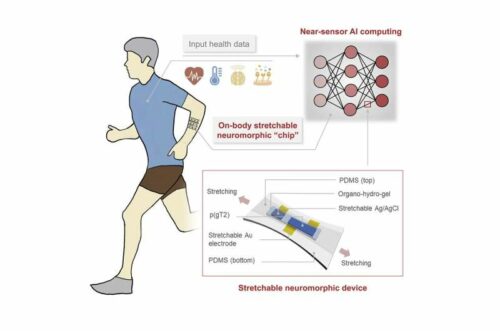- Researchers develop a stretchable wearable device that uses AI to monitor users’ health.
- This neuromorphic “chip” is made up of a thin film of a plastic semiconductor combined with stretchable gold nanowire electrodes.

Wearable technology possesses a limitless potential in our day to day life. It can be used as precision medical sensors designed to perform health monitoring and diagnosis. It would be like having a high-tech medical center at your instant beck and call.
Such a device would require collecting and processing a large amount of data. “The diagnosis for the same health measurements could differ depending on the person’s age, medical history and other factors,” Wang said. “Such a diagnosis, with health information being continuously gathered over an extended period, is very data-intensive.”
Researchers adapted to the neuromorphic computing technology to create a device that could mimic the operation of the brain and train itself using past data sets. They designed a skin-like neuromorphic “chip” consisting of a thin film of a plastic semiconductor combined with stretchable gold nanowire electrodes. Even when stretched to twice its normal size, their device functioned as planned without formation of any cracks.
The team developed an AI and trained it to distinguish healthy electrocardiogram (ECG) signals from four different signals indicating health problems. After training, the device was more than 95% effective at correctly identifying the ECG signals.
Researchers from the DOE’s Argonne National Laboratory and UChicago’s PME are developing skin-like electronics paired with AI for health monitoring and diagnosis. Such new wearable electronics paired with AI could transform screening for health problems. Credit: Wang Research Group
The plastic semiconductor also underwent analysis on beamline 8-ID-E at the Advanced Photon Source (APS). It was exposed to intense X-ray which revealed how the molecules that make up the skin-like device material reorganize upon doubling in length. These results provided molecular level information to better understand the material properties.
“The planned upgrade of the APS will increase the brightness of its X-ray beams by up to 500 times,” said Joe Strzalka, an Argonne physicist. “We look forward to studying the device material under its regular operating conditions, interacting with charged particles and changing electrical potential in its environment.” “While still requiring further development on several fronts, our device could one day be a game changer in which everyone can get their health status in a much more effective and frequent way,” added Wang.








